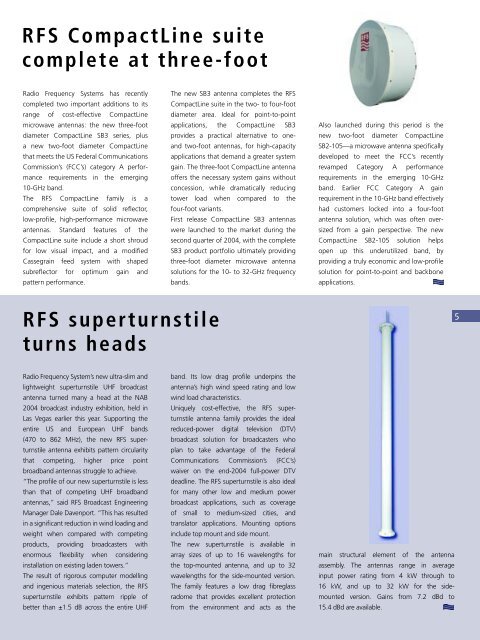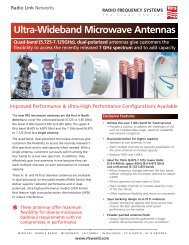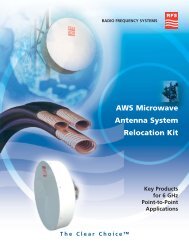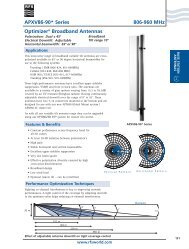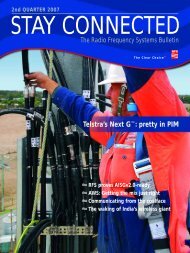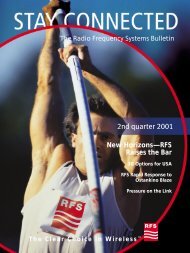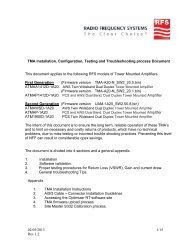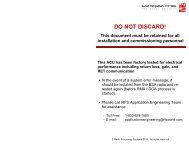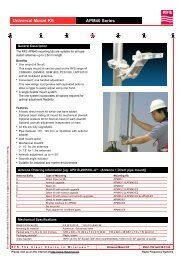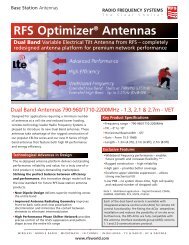download - Radio Frequency Systems
download - Radio Frequency Systems
download - Radio Frequency Systems
You also want an ePaper? Increase the reach of your titles
YUMPU automatically turns print PDFs into web optimized ePapers that Google loves.
RFS CompactLine suite<br />
complete at three-foot<br />
<strong>Radio</strong> <strong>Frequency</strong> <strong>Systems</strong> has recently<br />
completed two important additions to its<br />
range of cost-effective CompactLine<br />
microwave antennas: the new three-foot<br />
diameter CompactLine SB3 series, plus<br />
a new two-foot diameter CompactLine<br />
that meets the US Federal Communications<br />
Commission’s (FCC’s) category A performance<br />
requirements in the emerging<br />
10-GHz band.<br />
The RFS CompactLine family is a<br />
comprehensive suite of solid reflector,<br />
low-profile, high-performance microwave<br />
antennas. Standard features of the<br />
CompactLine suite include a short shroud<br />
for low visual impact, and a modified<br />
Cassegrain feed system with shaped<br />
subreflector for optimum gain and<br />
pattern performance.<br />
The new SB3 antenna completes the RFS<br />
CompactLine suite in the two- to four-foot<br />
diameter area. Ideal for point-to-point<br />
applications, the CompactLine SB3<br />
provides a practical alternative to oneand<br />
two-foot antennas, for high-capacity<br />
applications that demand a greater system<br />
gain. The three-foot CompactLine antenna<br />
offers the necessary system gains without<br />
concession, while dramatically reducing<br />
tower load when compared to the<br />
four-foot variants.<br />
First release CompactLine SB3 antennas<br />
were launched to the market during the<br />
second quarter of 2004, with the complete<br />
SB3 product portfolio ultimately providing<br />
three-foot diameter microwave antenna<br />
solutions for the 10- to 32-GHz frequency<br />
bands.<br />
Also launched during this period is the<br />
new two-foot diameter CompactLine<br />
SB2-105—a microwave antenna specifically<br />
developed to meet the FCC’s recently<br />
revamped Category A performance<br />
requirements in the emerging 10-GHz<br />
band. Earlier FCC Category A gain<br />
requirement in the 10-GHz band effectively<br />
had customers locked into a four-foot<br />
antenna solution, which was often oversized<br />
from a gain perspective. The new<br />
CompactLine SB2-105 solution helps<br />
open up this underutilized band, by<br />
providing a truly economic and low-profile<br />
solution for point-to-point and backbone<br />
applications.<br />
RFS superturnstile<br />
turns heads<br />
5<br />
<strong>Radio</strong> <strong>Frequency</strong> System’s new ultra-slim and<br />
lightweight superturnstile UHF broadcast<br />
antenna turned many a head at the NAB<br />
2004 broadcast industry exhibition, held in<br />
Las Vegas earlier this year. Supporting the<br />
entire US and European UHF bands<br />
(470 to 862 MHz), the new RFS superturnstile<br />
antenna exhibits pattern circularity<br />
that competing, higher price point<br />
broadband antennas struggle to achieve.<br />
“The profile of our new superturnstile is less<br />
than that of competing UHF broadband<br />
antennas,” said RFS Broadcast Engineering<br />
Manager Dale Davenport. “This has resulted<br />
in a significant reduction in wind loading and<br />
weight when compared with competing<br />
products, providing broadcasters with<br />
enormous flexibility when considering<br />
installation on existing laden towers.”<br />
The result of rigorous computer modelling<br />
and ingenious materials selection, the RFS<br />
superturnstile exhibits pattern ripple of<br />
better than ±1.5 dB across the entire UHF<br />
band. Its low drag profile underpins the<br />
antenna’s high wind speed rating and low<br />
wind load characteristics.<br />
Uniquely cost-effective, the RFS superturnstile<br />
antenna family provides the ideal<br />
reduced-power digital television (DTV)<br />
broadcast solution for broadcasters who<br />
plan to take advantage of the Federal<br />
Communications Commission’s (FCC’s)<br />
waiver on the end-2004 full-power DTV<br />
deadline. The RFS superturnstile is also ideal<br />
for many other low and medium power<br />
broadcast applications, such as coverage<br />
of small to medium-sized cities, and<br />
translator applications. Mounting options<br />
include top mount and side mount.<br />
The new superturnstile is available in<br />
array sizes of up to 16 wavelengths for<br />
the top-mounted antenna, and up to 32<br />
wavelengths for the side-mounted version.<br />
The family features a low drag fibreglass<br />
radome that provides excellent protection<br />
from the environment and acts as the<br />
main structural element of the antenna<br />
assembly. The antennas range in average<br />
input power rating from 4 kW through to<br />
16 kW, and up to 32 kW for the sidemounted<br />
version. Gains from 7.2 dBd to<br />
15.4 dBd are available.


